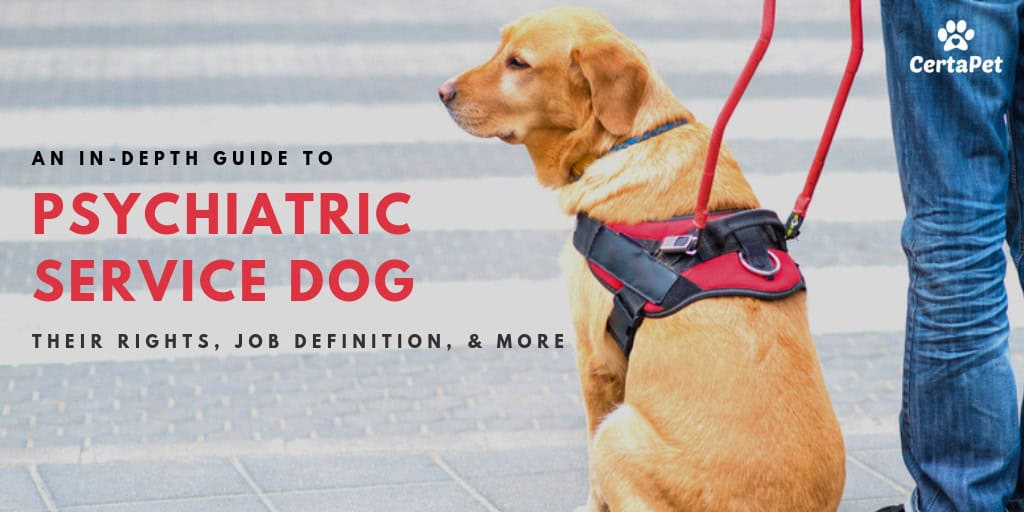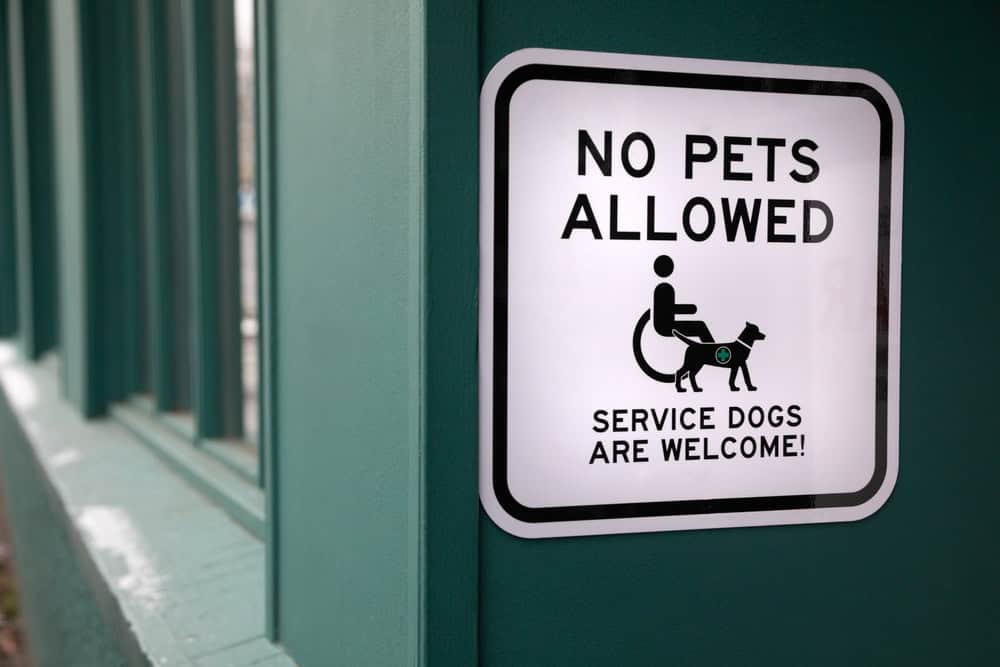Everything you need to know before flying with your dog for free
It’s been estimated that 1 in 4 Americans currently live with a mental health illness. Some of the more well-known mental health illnesses include depression, anxiety, bipolar disorder, post-traumatic stress disorder (PTSD), and phobias such as social phobia or agoraphobia (the fear of places and situations that might cause panic, helplessness, or embarrassment).

Mental health illnesses such as those above account for many of the top causes of disability in the United States. Individuals who live with a mental health illness will often work with a licensed mental health professional to develop a treatment plan that best suits their needs.
As mental health illnesses are becoming more and more recognized, supported, and understood, those who live with them are increasingly turning to healthy, natural alternatives when developing their treatment plans. This includes the use of assistance animals such as psychiatric service dogs.
What is a Psychiatric Service Dog?
Click the below video to learn more about psychiatric service dogs.
A psychiatric service dog (PSD) is a type of assistance animal that’s trained to perform specific tasks for individuals living with a mental illness. These unique tasks are directly related to the handler’s disability.
Most of us are accustomed to seeing guide dogs supporting those with physical disabilities like a hearing or sight impairment. However, a psychiatric service dog helps people with typically unseen, unnoticeable disabilities.
For example, veterans with post-traumatic stress disorder (PTSD) who experience panic attacks or similar challenges can greatly benefit from the service of a PSD. Those who live with social phobia or other anxiety disorders can also find the service of a PSD to be incredibly beneficial.
What Conditions Can a Psychiatric Service Dog Help With?
Some of the most common mental health conditions that may necessitate the assistance of a PSD include:
- Post-Traumatic Stress Disorder (PTSD)
- Depression
- Anxiety Disorders
- Obsessive-Compulsive Disorder (OCD)
- Attention-Deficit/Hyperactivity Disorders
- Bipolar Disorders
- Social Phobias
- Schizophrenia
- Agoraphobia
- Claustrophobia
- Panic Disorders
- Autism
What are Psychiatric Service Dogs Trained to Do?
Psychiatric service dogs assist their owners by performing special tasks that can help alleviate the individual’s depression, anxiety, phobia, etc. These tasks will be specific to the PSD’s owner and will typically be something that the person cannot do themselves.
Assistance from psychiatric service dogs can be physical, or it can require the dog to use their natural senses. Either way, a trained PSD will typically serve as a buffer in certain situations and read signals from their handler to help them in whatever way is needed.
Here are just some of the many ways that a PSD can help their owner:
Ease Claustrophobia
In crowded and claustrophobic situations, a PSD can act as a non-protective buffer to provide their human with some needed space. The dog can increase the personal bubble by standing between their handler and other people so that their owner is at ease and comfortable.
Additionally, for some, visiting amusement parks, markets, or similarly crowded spaces can overwhelm a person and trigger anxiety and/or panic. A PSD will recognize the physical stress signs in their handler or read their handler’s signals and know to immediately lead their human to a spacious area.
Assess Any Threats
Approaching a space that should be empty can be a trigger for someone with PTSD, just as turning a corner can sometimes cause anxiety.
These simple life activities are trying for someone with PTSD or similar anxiety disorders. Having a dog enter a space and carry out a room search can be incredibly calming for such an individual.
Therapeutic and Tactile Distraction
Tactile stimulation and pressure therapy can help ground a person and offer a therapeutic distraction from anxiety, depression, or a pending panic attack from PTSD.
Dogs can be trained to place pressure on their handler’s chest or lap to encourage emotional regulation and bring calm to a situation.

Medical Assistance or Reminder
A psychiatric service dog can remind their handler when it’s time for medication and continue to pester them until they take their drugs.
If an individual cannot retrieve the medication due to nausea or lethargy, they can train their dog to fetch it for them, along with a bottle of water.
Balance Assistance
Prescribed medication for some mental health disorders may result in side effects such as lethargy, lameness, and confusion. This can make it challenging for an individual to walk without balance assistance.
A psychiatric service dog can move their handler to a safe space or support them with a harness in these situations.
Night Terror Alert
Service animals can wake their handlers during a night terror and provide a distraction from a harrowing flashback.
By reorientating their handler, the PSD can assist in lifting them out of a terrifying episode.
Retrieve Help
Individuals who suffer from certain psychiatric disabilities can find themselves in situations where crippling fears and escalating symptoms could necessitate medical assistance.
This is sometimes seen in those with PTSD or anxiety disorders. Service dog handlers can signal to their service dog that they need to fetch help.
Relief from Sensory Overload or Stress
Some situations may prove to be stressful or overwhelming for people with certain mental health conditions. To avoid explanation or awkward departures, these individuals can signal to their psychiatric service dog to tug at their leg, as if signaling for a toilet break.
This task may seem simple, but by avoiding the emotional buildup and social claustrophobia, the individual can regain emotional control.
Companionship
While PSDs are trained to perform specifics tasks, this does not take away from the fact that they are animals that display loyalty, love, and companionship for their handlers.
Endless studies share the many ways that dogs benefit our health, from an increased zest for life to even reducing blood pressure.
Selective Solitude or Reclusiveness
Psychiatric service dogs can encourage an individual to leave home and engage with people when they would usually opt for solitude.
A psychiatric service dog encourages ventures into the outdoors while also providing support for their owner when they get out of their comfort zone. Dogs can also facilitate social interactions while also putting their person at ease if such social situations become too stressful.
Federally Protected Rights for Psychiatric Service Dogs

Those with service dogs rely on their animal to support them in various situations. The dog cannot perform his job, however, if he’s left at home or tied up outside a store.
Service dogs are therefore permitted public access to places where pets or emotional support animals are normally not allowed.
Federal laws protect and support psychiatric service dogs in the following ways:
- Public Access Rights
The ADA gives disabled persons the right to be accompanied by a service animal in public spaces. Service dogs must be well behaved, stay on the floor or in a harness, and cannot override public health rules (such as entering a public swimming pool).
Service animal handlers should be aware that religious institutions are exempt from the ADA and are not required to permit access to service dogs. Your state may have specific laws that apply in this case.
- Travel Privileges
The Air Carrier Access Act (ACAA) of 1986 prohibits refusal and discrimination towards individuals based on their disability and their need for a service animal to accompany them. The ACAA allows disabled owners to take their service animal onboard a flight, in the cabin, without paying extra fees.
For those who intend on traveling with their PSD, it’s important to note that the Department of Transportation (DOT) permits airlines the right to ask PSD owners to submit a certification form before departure. The form requires the individual to provide certain certifications, including proof that their PSD has been trained to assist with a disability and is capable of good behavior on a flight. You can learn more about what it’s like to travel with a PSD here.
- Fair Housing
The Fair Housing Act (FHA) protects people with disabilities (mental or physical) from discrimination when it comes to accommodation.
Landlords cannot deny housing to anyone based on their diagnosis. People with assistance animals, such as PSDs, are protected under the FHA even if the property has a “no pet” policy.
- Educational Facility Access
The Individuals with Disabilities Education Act (IDEA) allows students to bring service dogs such as psychiatric services dogs into places of education.
The Department of Justice has guidelines and rules, but they are not clear-cut, and individual cases need to be discussed depending on your state and school.
Verifying a Psychiatric Service Dog
The symptoms of mental health illnesses are not always visible to others. As such, it’s not uncommon to expect a request for verification, especially when entering a place with a “no dogs” rule.
According to the ADA, the staff of an establishment can legally ask the following questions:
- Is the dog a service animal required because of a disability?
- What work or task has the dog been trained to perform?
No one has the right to ask you to identify your specific disability or ask that your pet demonstrate their skill.
As previously mentioned, the DOT gives airlines the right to also request further certifications when flying with your pet. Make sure you follow all requirements and provide these certifications beforehand, as to allow for more stress-free travel.
While not a requirement, it can also be helpful to fit your animal with a service dog vest, service dog harness, or service dog ID card.
Emotional Support Animals vs. Psychiatric Service Dogs: What’s the Difference?

Over the centuries, dogs have performed many jobs to assist their human companions.
As a result, there are many types of assistance animals in today’s society.
Here are the four main types of assistance animals and what their job typically encompasses.
- A Service Dog receives extensive training to help individuals with tasks or activities that their disability limits or prevents them from doing on their own. Under the American’s with Disabilities Act (ADA), service dogs can accompany their owners in a wide range of public areas because of the tasks they do. One of the most common types of service dogs is a seeing-eye dog for the visually impaired.
- A Psychiatric Service Dog also receives specialized training in order to perform certain tasks for an individual, the only difference being that a PSD usually helps those with unseen, unnoticeable disabilities (anxiety, panic, post-traumatic stress, depression). Just like other service dogs, PSDs have public access rights and certain travel and housing privileges.
- Emotional Support Animals are companion animals whose presence can help alleviate symptoms of mental illness. Dogs and cats are the most common types of ESAs and require no formal training to be recognized as an assistance animal. However, ESAs don’t have the same federally protected rights as trained service dogs and may not always be able to accompany their owners in public places or on planes, based on the guidelines that the specific establishment or airline has in place.
- Therapy Dogs can often be found in hospitals or nursing homes. The presence of a therapy dog can bring comfort, social interaction, reduced stress, and joy into patients’ or residents’ lives. Therapy dogs usually undergo specialized training in order to work in these special settings. Another type of therapy dog is a ‘Comfort Dog,’ which visits disaster areas or areas of crisis to calm victims and bring them comfort.
How to Get a Psychiatric Service Dog
The first step in getting a psychiatric service dog is to speak with a licensed mental health professional (LMHP).
If your LMHP agrees with you that a PSA would be a beneficial addition to your treatment plan, they will write a letter of recommendation which confirms your need for a psychiatric service dog.
Once you have this letter of recommendation from your LMHP, you can move forward to the next step in the process: finding your new assistance animal.
The dog can be one that’s already a part of your family or it can be one that you adopt. There are no requirements when it comes to breed type, which allows individuals more leeway when it comes to adopting an animal from a rescue group or a local animal shelter.
Individuals can also request a service dog from a specialized service dog organization, although there are usually steep fees involved with this option. The average cost of a service dog for those who opt to go this route is $15,000-$30,000 up front.
An animal from a service dog organization will have already received the full range of training required for the animal to perform the tasks you require.
If you decide to use a dog you already own or plan to adopt, you’ll need to provide special training for the animal to qualify as a PSD.
How to Train a Psychiatric Service Dog
When it comes to training your animal to perform specific tasks as your psychiatric service dog, there are several options available.
The ADA and the DOT permit owners to self-train their service animals. Using guidelines such as those provided by the General Public Access Test will enforce good behavior in your service dog when you’re visiting public spaces and are around other people.
There’s also the option to get a service dog from a specialized service dog organization. As previously mentioned, an animal from a service dog organization will have already received extensive training. However, the average cost of an animal from such an organization ranges from $15,000-$30,000.
The most popular option is to simply seek the services of a professional dog trainer. This is a preferable option for many who simply don’t have the time or energy to research training methods and best practices in addition to preparing a ‘curriculum’ for their service dog that meets guidelines like the General Public Access Test. A dog trainer brings years of experience and knowledge to the table and can more quickly teach your dog to perform all needed tasks, saving you the headache of doing it yourself. Working with a trainer can also help you and your service dog better understand each other’s body language and further build your bond. A trainer can also help you come up with appropriate signals to give your psychiatric service dog when you need a specific task performed.
Learn more about training a psychiatric service dog here.

Interested in Getting a Psychiatric Service Dog?
Psychiatric service dogs play an important role in the lives of their owners.
They can help with mental health conditions like depression, anxiety, PTSD, social phobias, and more by performing certain tasks that can help alleviate the symptoms of these disorders.
Because of the service they provide, psychiatric service dogs have federally protected rights that allow them access to public places. They also are entitled to certain travel and housing privileges. This way, they never have to be separated from the human who relies on their help.
Are you interested in getting a psychiatric service dog?
Here at CertaPet, we can help. Certapet is an online telehealth platform that improves access to mental health care in the U.S. with a focus on providing services to individuals who are seeking animal assisted interventions as part of their treatment plan.
We are currently coordinating with dog trainers who specialize in the service animal space and who will soon work in tandem with our network of licensed mental health professionals to make the process of getting and training a psychiatric service dog affordable, convenient, and hassle-free. We’ll have more information available soon about our Psychiatric Service Dog Training options. In the mean time, you can take our FREE pre-screening below to see if you qualify for a PSD!
FAQs
Who can prescribe a psychiatric service dog?
A licensed mental health professional (LMHP) can prescribe an assistance animal such as a psychiatric service dog as part of an individual’s treatment plan.
Can psychiatric service dogs go anywhere?
The ADA gives disabled persons, including those with a mental health disability, the right to be accompanied by a psychiatric service animal in public spaces. The service dog must be well behaved, stay on the floor or in a harness, and cannot override public health rules (such as entering a public swimming pool). Religious institutions are exempt from the ADA and are not required to permit access to service dogs.
What tasks can a psychiatric service dog perform?
Psychiatric service dogs assist their owner by performing tasks that can help alleviate the individual’s stress, anxiety, depression, and/or other symptoms. From retrieving medication and assisting with emotional regulation to conducting room searches or serving as a buffer in overwhelming situations or crowded spaces, PSDs can be individually trained to perform several tasks for their handler’s unique needs.
